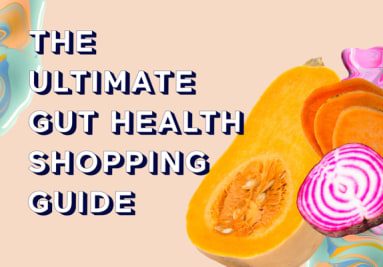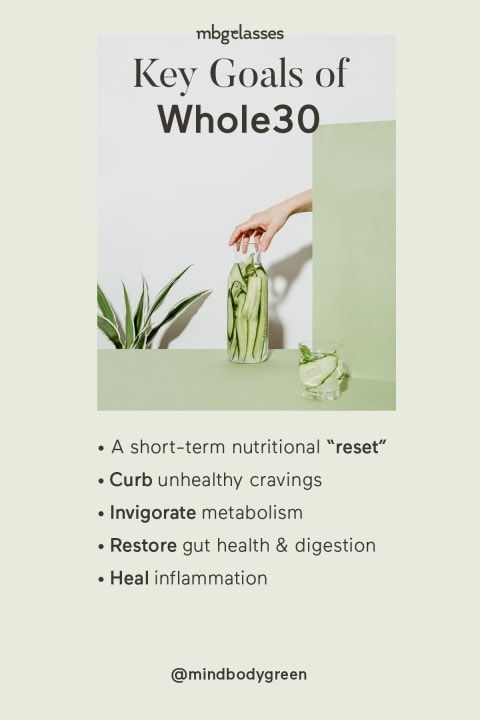In an effort to help you navigate the clean diet, we tracked down answers to all the big questions surrounding Whole30, including the following: what you can and can’t eat, how you’ll feel, whether you’ll lose weight, and some sample meal plans. From the founders’ lips to your ears (or rather eyes), everything you need to know about the Whole30 diet is spelled out right here. Whole30 is known for being as effective as it is no-nonsense (and fans of Whole30 think it’s very, very effective). It demands 100% commitment, no excuses. Whoever chooses to embark on Whole30, a wealth of benefits supposedly awaits them at the other side of 30 days. We’ll touch on those benefits later, but for now let’s talk about food. Here’s what you can eat on Whole30: If you’re thinking “that’s a very short list,” it encompasses more food than you think; just keep reading. If you read the list and thought, “Wow, that looks a lot like my current diet,” that could be true, but the “do not eat” list is long and precise—it may paint a better picture of how much sacrifice you have to make on Whole30. There are exceptions to the rules, but they’re nothing to write home about. Say goodbye to any and all added sugar, real or fake. This includes sugar, corn syrup, maple syrup, honey, agave nectar, coconut sugar, date syrup, stevia, Splenda, Equal, NutraSweet, xylitol, or any product that resembles these. That once-a-year diet soda you allow yourself at a baseball game? Toss that out. The paleo cookie recipe you love? Not for today, or the next 29 days. You get the picture—if it has any sugar or sugar look-alike, it’s a hard pass on Whole30. No alcohol—no drinking it, and no cooking with it. Sorry, no exceptions here. Ditch the booze in every way, shape, and form. Eliminate all grains from your diet. This rule tends to jar most people, especially those who are primarily plant-based, vegetarian, or vegan. And “grains” doesn’t just mean gluten-filled grains—Whole30 cuts out all of them. Wheat, rye, barley, oats, corn, rice, millet, bulgur, sorghum, sprouted grains, quinoa, amaranth, and buckwheat all make the off-limits list. It’s worth mentioning that these ingredients aren’t always listed with their real names. Urban strongly advises a close reading of labels, as companies sneak wheat (and sugar) into products under the guise of pseudonyms. Ingredients like hydrolyzed vegetable protein, cereal extract, and glucose syrup often contain wheat, so steer clear of those. If you don’t recognize an ingredient or can’t pronounce it, Urban has an easy solution: “When in doubt, leave it out.” No legumes, including all beans. Farewell, dearest beans—black, red, pinto, navy, white, kidney, lima, fava, you name it. So long, peas, chickpeas, lentils, and peanuts. You have no place here on the Whole30 diet, including you, our beloved peanut butter. And if you think soy products are allowed, you are sadly mistaken (it’s called a soybean after all). Give away your soy sauce, miso, tofu, and tempeh; leave the edamame off your takeout order, and keep an eye out for soy lecithin—that’s not allowed either. No dairy, regardless of what animal it comes from. Cow, goat, sheep, or any animal-derived milk, cheese, cream, yogurt, kefir, sour cream, ice cream, and frozen yogurt are not to be touched while you’re on Whole30. Carrageenan, MSG, and sulfites? No, no, and no. Another reason to check food labels—many processed foods contain additives to extend their shelf life, or make them taste better. Avoid any and all additives on Whole30, and you’re golden. No more “healthy” or “approved” treats. Remember how we said Whole30 can change your life? It won’t if you exploit the loopholes. As the Whole30 site states, recreating or buying sweets and treats with approved ingredients is missing the point of Whole30 and will undermine your results. The examples given include pancakes, waffles, bread, tortillas, biscuits, muffins, cupcakes, cookies, brownies, pizza crust, non-wheat pastas, cereal, ice cream, any sort of chips, and fries. If you’re feeling overwhelmed by the rules, you can always try out a Whole30 meal delivery service to simplify your your food prep. YES: Ghee or clarified butter, not regular butter. This is the only dairy allowed on Whole30. Cherish it with all of your being. YES: Fruit juice The Whole30 guidelines say that fruit juice is OK if it’s used as a stand-alone ingredient or natural sweetener in a recipe. You shouldn’t drink a gallon daily, but a little bit here and there is allowed in place of sugar. YES: Some legumes Plant lovers, rejoice! Green beans, sugar snap peas, and snow peas have the green light on Whole30. YES: Vinegar Malt vinegar is out (damn you, gluten), but all other types (white, red wine, balsamic, apple cider, and rice) are Whole30-compliant. YES: Coconut aminos A tasty alternative to soy sauce, coconut aminos are permitted on Whole30, even if it contains coconut nectar or coconut syrup. YES: Salt (Thank goodness.) Little-known fact: Iodized table salt contains sugar, usually in the form of dextrose. This sugar keeps the potassium iodide in salt from “oxidizing and being lost.” But for the purposes of Whole30, and because all food purveyors use salt (and most prepackaged foods contain it), salt is in the clear. If you feel nervous or hesitant to start Whole30, know that so, so many people have completed it before you—and if reading other people’s stories empowers you, you should go for it. Perhaps the most significant change you’ll have to get used to is not having unhealthy foods to turn to when you feel stressed, anxious, or under pressure—meaning you’ll have to find another way to handle your emotions. Food has the ability to quench our thirst for comfort, but using food to cope isn’t the healthiest habit to have, and it can be hard to break. Consider Whole30 an opportunity to find a more fulfilling antidote or to work through feelings that you’d otherwise suppress or ignore—it’ll help you complete Whole30, and beyond that, you’ll have a mode of stress management that you can use for the rest of your life. Whole30 is meant to be a total reset, and if you slip up, that reset is null and void. “You have to completely eliminate the potentially problematic foods in question to accurately evaluate their impact,” Urban says. “Yes, even small amounts of off-plan foods can mess up your reset.” And if we’re honest with ourselves, we know slip-ups breed slip-ups—if you slip up once, chances are it’ll happen again. “Giving yourself an out before you even begin leaves the door wide-open to justification and rationalization for comfort eating, stress eating, and giving in to peer pressure. Keep that door closed!” To reiterate: If you stray from the path, you’ll have to begin again. You’ll inevitably feel a sense of freedom when it’s over (who wouldn’t?), but the physiological and psychological changes you experience post-Whole30 are meant to change your view on food and your body forever. Nothing is guaranteed, but there’s a reason that people keep doing it. Why no scale then? Well, the founders insist that Whole30 is about much more than weight loss—there are “other dramatic, lifelong benefits” that Whole30 has to offer. The only time you weigh yourself is before you start Whole30 and after you finish it, and that’s so you can see the more tangible results. “While some people may have an unhealthy emotional relationship with coffee, the foods we eliminate have a much bigger impact on your overall health (your hormones, digestion, and inflammation) than your cup of morning java—and figuring out how those affect you is our primary goal,” Urban says. “Plus, giving up coffee and doing a Whole30 is like doing two self-experiments at once, and it’ll be really hard to tease apart the side effects, both good and bad.” If you’re still itching to kick caffeine, Urban recommends doing so after finishing Whole30. Most Whole30 participants end up unintentionally drinking less coffee because they can’t add dairy or sugar to it, and many forgo coffee afterward because they feel so great without it. “Post-Whole30, your energy will be up, and you’ll be sleeping better, making it easier to go without all that caffeine in the morning.” Whole30 takes “the most common craving-inducing, blood sugar-disrupting, gut-damaging, inflammatory food groups” out of our diets in part because it’s supposed to make us feel better but also because it helps us learn what we’re sensitive to. If you eliminate food groups that tend to elicit bodily reactions (like wheat, dairy, and soy) for 30 days, and then reintroduce them one by one, you’ll have a clear indication of which food groups negatively affect you and which your body does fine with. “If you skip reintroduction and start Day 31 with pizza, ice cream, and beer all at the same time, you’ll be missing half the information you could have gained from the program,” Urban says. “It seems wasteful to give up stuff you really like for 30 whole days and not learn which foods were contributing to your allergies, asthma, breakouts, bloating, etc.” If you’re looking for more reintroduction phase guidance, Urban outlines a reintroduction schedule in her add-on book Food Freedom Forever, which also includes a three-part Food Freedom plan that aims to change your relationship with food once and for all. We at mindbodygreen have tried our fair share of Whole30-friendly products, and we’ve gleaned plenty of inspiration from the Whole30 queen herself. In terms of snacks, here are a few solid options: Breakfast: Vegetable frittata, using any vegetables you have on hand, served hot or cold. Another combination she loves is eggs and berries—yes, together. She has soft-scrambled eggs with blueberries, blackberries, baby spinach, fresh basil, and chopped walnuts. Lunch: A protein salad (a recipe you can find in the Whole30 book), using either canned chicken, salmon, or tuna as the base. She mixes a protein with Primal Kitchen mayo, apple cider vinegar, celery, green apple, red pepper, dried cranberries (sweetened with fruit juice, not sugar), scallions, and slivered almonds, which she serves atop a bed of baby greens. Dinner: “Ground meat with stuff over stuff” is how Urban describes one of her favorite dinners. Choose a meat (ground beef, chicken, or turkey), sauté with vegetables, and serve over zucchini noodles, cauliflower rice or mash, baby spinach, or sweet potato hash. Kelly LeVeque also has some flavorful Whole30 meal ideas; see below: Breakfast: A veggie and egg scramble with mushrooms, bell peppers, green onions, and a side of berries. Coffee if you want, because you can. Lunch: A turkey taco salad with seasoned turkey taco meat, guacamole, and a vinaigrette. Snack: A handful of mixed nuts (just not peanuts) and a banana. Dinner: A spinach salad with grilled chicken, sweet potatoes, and squash. Otherwise, why not give Whole30 a shot? There’s a lot you can learn and, like we promised, plenty to eat.




